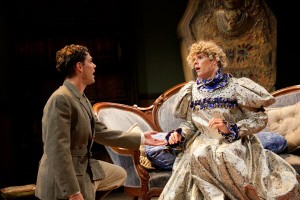Audiences step into the Victorian home of Lord Edgar Hillcrest and Lady Enid Hillcrest to solve “The Mystery of Irma Vep” in the Kitchen Theatre’s latest production.
The play features a number of outrageous genres of theater in combination with multi-talented actors.

The show begins on a “dark and stormy night,” which reflects the rocky nature of the relationship between Lord Edgar (Jesse Bush) and his new, young bride, Lady Enid (Tony Roach). The story follows their quest to find the answers surrounding the death of Lord Edgar’s late wife, Irma Vep.
While the story features many characters, all of the roles are played by Bush and Roach. These two men play everyone from a wooden-legged servant to a re-awakened Egyptian princess.
Both Bush and Roach showcase their talent through the manipulation of their bodies and voices to portray each character to match outrageous costumes by Lisa Boquist. Bush’s transformation from Jane Twisden to Lord Edgar is complete with a change in posture, sticking his chest up and out, and the octave his voice rises to sound like a woman. One of Roach’s characters, Nicodemus Underwood, has a limp due to his wooden leg in addition to an exaggerated English accent.
These gifted actors have help from the sound, lighting and set design as well. The sound effects are used sparingly and comically, such as the sound of thunder used after the repetition of a specific word, which plays an important role in the comedic relief of the story. This is similar to the use of light in the production — blackouts and extreme lighting are only employed when necessary. The set allows for two entrances and exits, which permits the quick costume changes that take place to propel the characters’ stories forward.
Each costume is specific to each character. The character Nicodemus Underwood is equipped with items such as cargo pants, boots — for his wooden leg — and a cape that clearly shows his posh social status, whereas Lady Enid’s dresses and robes are more extravagant and rich in color. The Victorian style of the dresses is telling of the time period, and even the male characters’ costumes — hidden underneath dresses for quick changes — are fitting to the period.
Bush and Roach help create the farcical world of the play by taking the words of Charles Ludlam and direction of Rachel Lampert and incorporating the audience and contemporary jokes into their performance. By walking through and touching some audience members, the performance is more engaging, relevant, and a stark contrast to the time period of the play. These moments and others that may seem like mistakes turn into even more comedic moments with Bush and Roach’s creative ad-libbing and improvisation.
Lampert’s timely direction covers many of the points during which the actors need time to change their costume and character. At times, some lines are even spoken behind the main stage. These instances occur mostly when the characters speaking to each other were played by the same actor.
While the play is entertaining and comical, there are moments of disorder. At times, the nonsensical nature of the characters distracts from the dialogue, which results in some confusion in the plot. Audiences may have questions as to what is happening in certain moments.
But these moments are overshadowed by the absurd and hilarious nature of this production. Bush and Roach’s off-the-cusp nature, in combination with Lampert’s clever direction, will give audiences the clues to solve this side-splitting, pun-filled mystery.
“The Mystery of Irma Vep” plays through Dec. 18 at the Kitchen Theatre.




